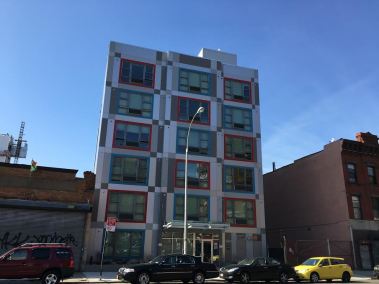By Michael Dobuski

The “Lego Building” was created to provide homes for the homeless in New York City. (Michael Dobuski/The Fordham Ram)
The area between 165th and 166th streets on Third Avenue in the Morrisania neighborhood of the Bronx has become more colorful with the recent addition of a unique block of apartments. The structure has been dubbed “The Lego Building” by locals because of its blocky red and blue exterior. The design is modular, which means that the main pieces of the structure are assembled off-site, and are then individually shipped to the building location. In this particular case, the units, which are over 700 square feet, were assembled by a company specializing in modular manufacturing called Capsys Corporation in Brooklyn, which sits on a former used car lot. According to a recent profile in the Wall Street Journal, the entire building took only three weeks to construct. Its peculiar creation is only part of the Lego Building’s story, however. Over half of the 68 residents now living there were at one point homeless.
The supportive housing that the Lego Building offers is organized by a non-profit called Services for the UnderServed, or SUS for short. Originally known as Seventh Day Adventist Charities, the organization was founded in 1978 and opened its first affordable housing locations in the early 1980s with a focus on helping adults in the Bronx with behavioral health concerns and developmental disabilities. In 1988, they became Services for the UnderServed, and now they operate in the Bronx, Manhattan, Brooklyn, Queens and Long Island. The Lego Building is the most recent of their efforts to provide service to the less fortunate. SUS developed the $22 million project in conjunction with the Bronx Pro Group, which is behind the construction of over 1000 housing units in the Bronx.
The completion of the Lego Building comes amid recent proposals from the mayor’s office regarding New York City’s affordable housing programs, including the Mandatory Inclusionary Housing Plan and the Zoning for Quality and Affordability Plan. The former is a rezoning strategy which would require developers to build more affordable housing in selected areas, while the latter seeks to allow taller buildings and less parking in some of the affected zones. The New York City Council will vote on these plans later this month.
Homelessness in New York City is a long standing problem. According to a census report from the NYC Department of Homeless Services, 60,296 people slept in shelters across the city in January 2016. The Bronx was hit particularly hard. A report from the Institute for Children, Poverty and Homelessness shows that in Kingsbridge Heights, the neighborhood with the seventh-highest number of homeless families in the Bronx, 94 percent more families required temporary housing in 2010 than in 2005. The same report cites gentrification as the cause for the Bronx’s growing housing problem, with individuals and families being driven out of their homes by the rising cost of rent.
At Fordham, the Midnight Run is a monthly project operated by Global Outreach which focuses on delivering food, toiletries and donated clothes to homeless individuals in New York City. Though the program operates in Manhattan, the Midnight Run’s head coordinator from Fordham, Erin Biggins, FCRH ‘17, recognizes the challenges that the Bronx faces. “Before the group embarks on a Midnight Run, we ask them the question, ‘What is one word that comes to mind when you see a homeless person?,’” Biggins said. The objective of this question is to help the group break down stereotypes of the homeless because it serves as a barrier when trying to interact with those we meet on the run. After each run, we have a reflection and ask them this same question to see how their perceptions of homeless have changed after learning about it firsthand.”
Projects such as the Midnight Run and the Lego Building, as well as a forthcoming 30-unit apartment complex, also developed by the Bronx Pro Group, seek to combat the Bronx’s homelessness problem. There is no word yet on whether the new building will be a modular construction, but more importantly, the finished product is expected to undercut the current market rate for Bronx apartments.
